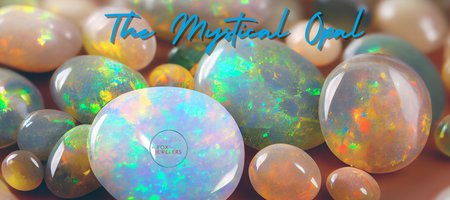October, a month of crisp autumn air, golden leaves, and the anticipation of the festive season is beautifully represented by its birthstone: the opal. This gem, with its play of colors and deep symbolism, has fascinated and enchanted humanity for centuries. In this post, we'll delve into the captivating world of opals, exploring their origins, meanings, and why they remain a beloved choice for jewelry.
Origins of Opal
Opals, often referred to as the "teardrops of the moon" or "fireworks of the earth," have a formation process as captivating as the gemstone itself. Their creation is a testament to nature's ability to craft beauty over time, and the story begins with a simple drop of rain.
As rainwater seeps into the earth, it carries with it dissolved silica, a compound in sand and glass. This silica-rich solution, over the course of thousands, if not millions, of years, finds its way into the cracks and crevices of underground rock formations. As the water eventually evaporates or drains away, the silica is left behind, and it begins to solidify and harden. Layer upon layer, the silica particles bond and form the opal's unique structure. This structure is responsible for the opal's signature play-of-color. The silica forms tiny spheres that stack in grids. When light enters the stone, it bends and refracts among these spheres, creating a mesmerizing kaleidoscope of colors.
Australia is the epicenter of opal production, with vast landscapes where conditions were just right for opal formation. Places like Coober Pedy and Lightning Ridge are renowned for their high-quality opals and have become pilgrimage sites for gem enthusiasts. However, the allure of opals is global. In the highlands of Mexico, the fire opals are found, while Brazil offers opals with a crystal-clear background, making their play-of-color even more pronounced. The United States, particularly in states like Nevada and Oregon, also has its share of opal mines, each with its unique variation of this beautiful gem.
In essence, every opal carries with it a tale of time, a journey of water and earth, and the magic of nature's alchemy.
A Palette of Colors
What sets Opal apart from other gemstones is its unique play of color. Tiny spheres of silica within the opal diffract light, creating a mesmerizing display of colors that can range from fiery reds and oranges to cool blues and greens. Depending on its type and origin, an opal might showcase a single color, a few closely related hues, or a broad spectrum.
Symbolism and Significance
Opals have been cherished for their supposed mystical properties. Ancient Romans believed opals were a symbol of hope and purity. They named the gem "opalus," which means "precious stone." The ancient Greeks, on the other hand, thought opals bestowed the gift of prophecy and protected its owner from diseases.
In modern times, opals are seen as a symbol of confidence and clarity. They are believed to amplify one's traits and characteristics, encouraging the wearer to express their true self.
Caring for Your Opal
Opals are relatively soft gemstones, ranking around 5.5 to 6.5 on the Mohs scale of hardness. They also contain a significant amount of water. As such, they require special care:
- Avoid sudden temperature changes, which can cause the stone to crack.
- Keep opals away from direct sunlight, which can dry out the stone and diminish its color.
- Clean opals using a soft cloth and mild soap. Avoid ultrasonic cleaners and harsh chemicals.
Opals, with their dazzling display of colors and rich history, are truly gems to be treasured. Whether you're celebrating an October birthday or simply drawn to the mystical nature of this gemstone, opals are a testament to nature's wonder and beauty. As the leaves change and the world prepares for winter, let the opal remind you of the warmth, color, and magic that exists in the world.

